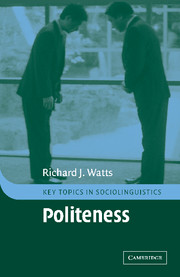Book contents
- Frontmatter
- Contents
- Preface
- 1 Introducing linguistic politeness
- 2 Politeness through time and across cultures
- 3 Modelling linguistic politeness (I)
- 4 Modelling linguistic politeness (II): Brown and Levinson and their critics
- 5 Facework and linguistic politeness
- 6 A social model of politeness
- 7 Structures of linguistic politeness
- 8 Relevance Theory and concepts of power
- 9 Politic behaviour and politeness in discourse
- 10 Politic behaviour and politeness within a theory of social practice
- Notes
- Glossary of terms
- References
- Index
Preface
Published online by Cambridge University Press: 24 November 2009
- Frontmatter
- Contents
- Preface
- 1 Introducing linguistic politeness
- 2 Politeness through time and across cultures
- 3 Modelling linguistic politeness (I)
- 4 Modelling linguistic politeness (II): Brown and Levinson and their critics
- 5 Facework and linguistic politeness
- 6 A social model of politeness
- 7 Structures of linguistic politeness
- 8 Relevance Theory and concepts of power
- 9 Politic behaviour and politeness in discourse
- 10 Politic behaviour and politeness within a theory of social practice
- Notes
- Glossary of terms
- References
- Index
Summary
Writing an introduction to politeness is like being in mortal combat with a many-headed hydra. You've barely severed one head when a few more grow in its place. The first head I needed to sever was whether politeness should be taken to include all forms of polite behaviour or to focus on polite language usage. For a linguist it was not difficult to chop off that particular head. It was obvious that an introduction to politeness should focus on forms of social behaviour involving language. But the problem was that, once I had severed that head, a whole set of other heads promptly emerged. Should an introduction to politeness, understood now as linguistic politeness, focus on the canonical models of politeness in language currently on the market? What is polite language in any case? Should an introduction to politeness reveal to the reader the wide scope of empirical research on politeness in fields as far apart as legal language, second language acquisition, business studies, gender issues, developmental psychology, etc.? At present I already have a bibliography that contains roughly 1,200 titles, and it is growing steadily week by week. Should an introduction to politeness focus more solidly on the theoretical issues informing this empirical research? Or would it not have been easier to write about linguistic structures that have traditionally been considered in the literature to be ‘polite’, e.g. honorifics, terms of address, polite formulaic utterances, indirect speech acts, etc.?
- Type
- Chapter
- Information
- Politeness , pp. xi - xivPublisher: Cambridge University PressPrint publication year: 2003

